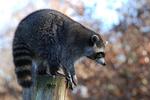| Home | About BFIS | Species List | Risk Analysis | Harmonia⁺ | Resources | Outputs | Mailing List | Registry |
| Contact us | Login | | ||||||
 |

© Vilda

©
Etienne Branquart, Belgian Biodiversity Platform
 Naturalization in Belgium Naturalization in Belgium
 Invasiveness Invasiveness
More on invasiveness: Raccoon prefers wetlands and old decidous forests with hollow trees, often adjacent to water. It is however able to adapt to a high diversity of other environmental conditions, including urbanised areas.
 Distribution in Belgium Distribution in Belgium
Established populations

 Impacts on Species Impacts on Species
 Impacts on Ecosystems Impacts on Ecosystems
More on impacts: In Japan and in the USA, large-scale changes in abundance of raccoons have had demonstrable negative consequences for different organisms due to its predation activity (e.g. ground nesting birds and amphibians). Increasing evidence of raccoon impact on native preys is also found in Western Europe since a few years, as a result of population increase in Germany and neighbour areas (see e.g. Fiderer et al 2019, Rabitsch et al 2020 and Cichocki et al 2021). Raccoon may also compete with native species for nesting cavities and also cause cascading effects on food webs (Kobayashi et al 2014, Suraci et al 2016). Raccoon is included in the appendix to the recommendation no 77 of the Council of Europe as a species which has proved to be a threat to biological diversity and for which eradication is strongly recommended.
References:
Bartoszewicz, M. (2006)
From online database of the North European and Baltic network on invasive alien species (NOBANIS).
Bartoszewicz, M., Okarma, H., Zalewski, A., Szczęsna, J. (2008)
Ann. Zool. Fennici 45 : 291-298.
Beltran-Beck, B., Garcia, F.J. & Gortazar, C. (2012)
Eur. J. Widl. Res. 58: 5-15.
Beltran-Beck, B., Garcıa, F.J. & Gortazar, C. (2012)
Raccoons in Europe: disease hazards due to the establishment of an invasive species.
Eur. J. Wildl. Res. 58(1): 5–15.
Cichocki, J., Ważna, A., Bator-Kocoł, A., Lesiński, G., Grochowalska, R., & Bojarski, J. (2021)
Predation of invasive raccoon (Procyon lotor) on hibernating bats in the Nietoperek reserve in Poland.
Mammalian Biology, 101(1), 57-62.
Duchêne, M.J. & Artois, M. (1988)
Les carnivores introduits: chien viverin (Nyctereutes procyonoides) et raton laveur (Procyon lotor).
In: Société pour l’Etude et la Protection des Mammifères (eds), Encyclopédie des carnivores de France, n° 4 et 6., Paris, 49 p.
Fiderer, C., Göttert, T., & Zeller, U. (2019)
Spatial interrelations between raccoons (Procyon lotor), red foxes (Vulpes vulpes), and ground-nesting birds in a Special Protection Area of Germany.
European Journal of Wildlife Research, 65(1), 14.
Fischer, M.L. et al. (2015)
Assessing and predicting the spread of non-native raccoons in Germany using hunting bag data and dispersal weighted models.
Biological Invasions DOI 10.1007/s10530-015-0989-x
Frantz, A.C., Cyriacks, P. & Schley, L. (2005)
Spatial behaviour of a female raccoon (Procyon lotor) at the edge of the species’ European distribution range.
Eur. J. Widl. Res. 51: 126-130.
Godin J. (2005)
Agence de l'Eau Artois-Picardie.
Hayama, H., Kaneda, M. & Tabata, M. (2006)
Rapid range expansion of the feral raccoon (Procyon lotor) in Kanagawa prefecture, Japan, and its impact on native organisms.
 In: F. Koike et al. (Eds), Assessment and control of biological invasion risks, Shoukadoh Book Sellers, Japan, 196-199.
Hohmann, U., Voigt, S. & Andreas, U. (2002)
Raccoons take the offensive: a current assessment.
In: I. Kowarik & U. Starfinger (Eds), Biologische Invasionen. Neobiota 1: 191-192.
Ikeda, T., Asano, M., Matoba, Y. & Abe, G. (2004)
Global Environmental Research 8: 125-131.
Kobayashi, F., Toyama, M., & Koizumi, I. (2014)
Potential resource competition between an invasive mammal and native birds: overlap in tree cavity preferences of feral raccoons and Ural owls.
Biological invasions, 16(7), 1453-1464.
Kunz, B. (2015)
Ist der Waschbär Procyon lotor eine Gefahr
für Cordulegaster boltonii? (Mammalia: Procyonidae; Odonata: Cordulegastridae).
Libellula 34 (3/4): 203–207.
Lammertsma D.R., Groot Bruinderink, G.W.T.A. & Broekhuizen, S. (2008)
Wasberen (Procyon lotor L. 1758) in Nederland: verspreiding, ecologie en mogelijke gevolgen voor Nederland.
 Alterra-rapport, Wageningen.
Lammertsma, D.R., Groot Bruinderink , G.W.T.A.& Broekhuizen, S. (2008)
Alterra,Wageningen, 25 pp.
Libois, R. (2006)
Les mammifères non volants de la région wallonne : tendances des populations.
Dossier scientifique réalisé dans le cadre de l'élaboration du Rapport analytique 2006 sur l'Etat de l'Environnement wallon, Unité de Recherches zoogéographiques, Université de Liège, 127 pp.
Léger, F. (1999)
Le raton-laveur en France.
Bulletin mensuel de l’Office National de la Chasse 241: 16-37.
Mitchell-Jones, A. J., Amori, G., Bogdanowicz, W., Kryštufek, B., Reijnders, P. J. H., Spitzenberger, F., Stubbe, M., Thissen, J. B. M., Vohralík, V. & Zima, J. (1999)
The Atlas of European Mammals.
Poyser, London.
Rabitsch, W., Aronsson, M., Strand, M. & Roscher, S. (2020)
Impact caused by Invasive Alien Species of Union concern on habitats and species of the Nature Directives and on Natura 2000 sites.
ETC/BD report to the EEA.
Schmidt, K.A. (2003)
Nest predation and population declines in Illinois songbirds: a case for mesopredator effects.
Conservation Biology 107: 1141-1150.
Suraci, J. P., Clinchy, M., Dill, L. M., Roberts, D. & Zanette, L. Y. (2016)
Nature communications 7(1): 1-7.
Van Den Berge, K. & De Pauw, W. (2003)
Amerikaanse nerts, Wasbeer, Wasbeerhond.
In: S. Verkem et al. (eds), Zoogdieren in Vlaanderen, Natuurpunt Studie & JNM-Zoogdierenwerkgroep.
Van Den Berge, K. & Gouwy, J. (2009)
Proceedings of the Science facing Aliens Conference, Brussels, 11th May 2009.
Vos, A., Ortmann, S., Kretzschmar, A.S., Köhnemann, B. & Michler, F. (2012)
The raccoon (Procyon lotor) as potential rabies
reservoir species in Germany: a risk assessment.
Berliner und Münchener Tierärztliche Wochenschrift 125:228–235.
|
 |
 |







